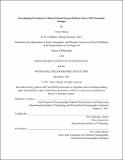| dc.contributor.advisor | Boyle, Edward A. | |
| dc.contributor.author | Huang, Tianyi | |
| dc.date.accessioned | 2022-02-07T15:10:26Z | |
| dc.date.available | 2022-02-07T15:10:26Z | |
| dc.date.issued | 2021-09 | |
| dc.date.submitted | 2021-10-19T13:40:26.050Z | |
| dc.identifier.uri | https://hdl.handle.net/1721.1/139880 | |
| dc.description.abstract | Chromium (Cr) isotopes have shown great potential as a paleo-redox proxy to trace the redox conditions of ancient oceans and atmosphere. However, its cycling in modern environments is poorly constrained. In my thesis, I attempt to fill in the gap of our understanding of chromium cycling in the modern ocean, with a focus on the redox processes in global oxygen deficient zones (ODZs).
Firstly, we developed a method to analyze Cr isotopes of different Cr redox species. Tests on processing conditions demonstrated its robustness in obtaining accurate Cr isotope data. It is applicable to both frozen and fresh samples. This method allows us to investigate the redox cycling of Cr that is hard to unravel by existing total Cr methods. Secondly, in the Eastern Tropical North Pacific (ETNP), Eastern Tropical South Pacific (ETSP) and Arabian Sea ODZs, their total dissolved Cr profiles show preferential reduction of isotopically light Cr(VI) to Cr(III), which is scavenged and exported to deeper oceans. Applying our new method to ETNP and ETSP ODZ seawater samples, we observed Cr(VI) reduction in both ODZs with a similar fractionation factor. This indicates similar mechanisms may be controlling Cr(VI) reduction in the two ODZs. Cr(III) maximum coincides with Fe(II) and secondary nitrite maximums in the upper core of both ODZs. Shipboard incubations with spiked Fe(II) showed fast Cr(VI) reduction occurring in the ETNP ODZ. But neither Fe(II) nor microbes were reducing Cr(VI) directly. Thirdly, we calculated the isotope effects of Cr scavenging in the ETNP and ETSP ODZs. The two ODZs show a similar isotope partitioning during Cr scavenging. And spatial variability is observed in the ETNP ODZ. Our calculated scavenged Cr isotope ratio is lighter than that of the total dissolved Cr from the same depth. It is also comparable to that of reducing or anoxic sediments, which implies that Cr isotopes can be used as an archive for local redox conditions. | |
| dc.publisher | Massachusetts Institute of Technology | |
| dc.rights | In Copyright - Educational Use Permitted | |
| dc.rights | Copyright retained by author(s) | |
| dc.rights.uri | https://rightsstatements.org/page/InC-EDU/1.0/ | |
| dc.title | Investigating Chromium Cycling in Global Oxygen Deficient Zones with Chromium Isotopes | |
| dc.type | Thesis | |
| dc.description.degree | Ph.D. | |
| dc.contributor.department | Joint Program in Oceanography/Applied Ocean Science and Engineering | |
| dc.contributor.department | Massachusetts Institute of Technology. Department of Earth, Atmospheric, and Planetary Sciences | |
| mit.thesis.degree | Doctoral | |
| thesis.degree.name | Doctor of Philosophy | |
